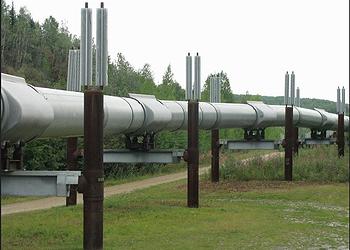
ALBUQUERQUE, New Mexico, June 7, 2019 (ENS) – A form of nanoscale corrosion is responsible for unpredictable breaks in the steel pipelines that carry oil, decreasing their working life, new research has found.
Steel pipes that carry oil can rust and eventually fail. The universal use of steel in pipeline infrastructure makes aqueous steel corrosion a global concern, with negative effects in most industrial sectors.
In the oil and gas industry, pipeline failures and the resulting disasters are avoided with strategic replacement programs, which rely on predictive models to develop the correct replacement timelines. But if the models go wrong, an environmentally costly problem can be created when detection comes too late to prevent a spill.

Now, researchers at Sandia National Laboratories, the Department of Energy’s Center for Integrated Nanotechnologies, and the Aramco Research Center in Boston, are using the most recent advances in liquid-cell transmission electron microscopy to capture the start of localized aqueous corrosion in carbon steel at the nanoscale and in real time.
With transmission electron microscopes, which shoot electrons through targets to take pictures, the researchers discovered that the root of the problem is a triple junction formed by a grain of cementite, which is a compound of carbon and iron, and two grains of ferrite, a type of iron.
This junction forms frequently during most methods of manufacturing steel pipe.
The researchers found that disorder in the atomic structure of these triple junctions makes it easier for a corrosive solution to remove iron atoms along that interface, according to a paper published April 12 in the journal “Materials Degradation,” an offshoot of the journal “Nature.”
In the experiment, the corrosive process stopped when the triple junction had been consumed by corrosion, but the crevice left behind allowed the corrosive solution to attack the interior of the steel.
Aramco senior research scientist Steven Hayden explained, “This was the world’s first real-time observation of nanoscale corrosion in a real-world material – carbon steel – which is the most prevalent type of steel used in infrastructure worldwide.”
“Through it, we identified the types of interfaces and mechanisms that play a role in the initiation and progression of localized steel corrosion,” Hayden said. “The work is already being translated into models used to prevent corrosion-related catastrophes like infrastructure collapse and pipeline breaks.”
To mimic the chemical exposure of pipe in the field, where the expensive, delicate microscopes could not be taken, very thin pipe samples were exposed at Sandia to a variety of chemicals known to pass through oil pipelines.
Sandia researcher and paper author Khalid Hattar put a dry sample in a vacuum and used a transmission electron microscope to create maps of the steel grain types and their orientation, much as a pilot in a plane might use a camera to create area maps of farmland and roads, except that Hattar’s maps had a resolution of only six nanometers. (A nanometer is one-billionth of a meter.)
“By comparing these maps before and after the liquid corrosion experiments, a direct identification of the first phase that fell out of the samples could be identified, essentially identifying the weakest link in the internal microstructure,” Hattar said.
Sandia researcher and paper author Paul Kotula said, “The sample we analyzed was considered a low-carbon steel, but it has relatively high-carbon inclusions of cementite which are the sites of localized corrosion attacks.”
“Our transmission electron microscopes were a key piece of this work, allowing us to image the sample, observe the corrosion process, and do microanalysis before and after the corrosion occurred to identify the part played by the ferrite and cementite grains and the corrosion product,” Kotula said.
When Hayden first started working in corrosion research, he said, “I was daunted at how complex and poorly understood corrosion is. This is largely because realistic experiments would involve observing complex materials like steel in liquid environments and with nanoscale resolution, and the technology to accomplish such a feat had only recently been developed and yet to be applied to corrosion.”
“Now we are optimistic that further work at Sandia and the Center for Integrated Nanotechnologies will allow us to rethink manufacturing processes to minimize the expression of the susceptible nanostructures that render the steel vulnerable to accelerated decay mechanisms,” said Hayden.
Localized corrosion is different from uniform corrosion, which occurs in bulk form and is highly predictable. Localized corrosion is invisible, creating a pathway observable only at its endpoint and increasing bulk corrosion rates by making it easier for corrosion to spread.
“A better understanding of the mechanisms by which corrosion initiates and progresses at these types of interfaces in steel will be key to mitigating corrosion-related losses,” the paper states.
“We thought of a possible solution for forming new pipe, based on changing the microstructure of the steel surface during forging, but it still needs to be tested and have a patent filed if it works,” said Sandia’s principal investigator Katherine Jungjohann, an author of the paper and lead microscopist. “But now we think we know where the major problem is.”
Copyright Environment News Service (ENS) 2019. All rights reserved.
© 2019, Environment News Service. All rights reserved. Content may be quoted only with proper attribution and a direct link to the original article. Full reproduction is prohibited.
